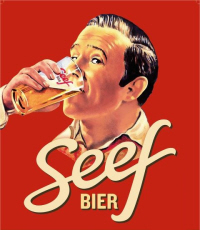Beer artist Van Dyck recreates the historic beer of Antwerp that was killed off by lager
Added: Sunday, July 1st 2012
Johan Van Dyck will have to put up with being called “an artist in beer” as his product, Seef, takes Belgium by storm. It was the top talking point at the Beer Passie festival in Antwerp at the end of June and earlier this year it won a gold medal in the World Beer Cup in the U.S. just a short time after its launch.
Seef – pronounced “safe” – is a brilliant recreation of an old beer style in Antwerp that was lost in the 20th century by what Johan calls “the rise of industrial lager”. When his recreation of the beer was launched in Antwerp City Hall the mayor hailed it as the city’s second greatest beer – he was careful not to overshadow De Koninck pale ale served in the famous bolleke glass.
Johan was marketing director at the large Duvel Moortgat brewing group but left to set up his Antwerpse Brouw Compagnie when he developed a passion for Seef and its history.
In the 18th and 19th centuries it was a major style in Antwerp and the surrounding region. It was produced by a large number of small breweries and its name is thought to come from one of the early brewing companies. It was so popular that one part of Antwerp was nicknamed Seef. The beer was consumed mainly by industrial workers who found its pale, cloudy appearance and blend of malt, hops and fruit wonderfully refreshing. One writer described it as “the working man’s champagne” as a result of its natural fermentation in bottle and the lively, spritzy head of foam when poured.
But, Johan explained, the style disappeared with the arrival of mass-marketed lager. The problem was made worse during World War One when the Germans seized copper brewing vessels in order to make tanks and bullets for the war effort.
When Johan set out to recreate the style he found that the original recipe for the beer had been kept a closely-guarded secret. But after months of painstaking work he came across the descendants of one of the brewers and they gave him the recipe, which had been kept in an old shoebox. With the help of scientists at the University of Leuven’s department of brewing and bio-chemistry, he discovered from the recipe that the beer was made with a blend of malted barley, wheat, buckwheat and oats, along with locally-grown Belgian hops.
That was the easy part. He couldn’t recreate the beer without yeast and he wanted an authentic culture. Leuven has a yeast bank with samples of every-known Belgian culture and the scientists came to the conclusion that the yeast used to ferment Seef was a mutated version of baker’s yeast. It was not unknown centuries ago for small businesses to make beer and bread alongside one another.
The university’s brewing department created as far as possible a yeast culture they believed to be close to the original. Johan was now in business and all he needed was a brewery prepared to make the beer for him. He found salvation at the large Roman Brewery in Oudenaarde, best-known for its Oud Bruin beer. He is delighted by Roman’s devotion to the beer but, as a result of Seef’s remarkable success, he plans to build his own plant in Antwerp to give it greater authenticity.
Seef falls in to the wheat beer category but it’s not a spiced style made famous by Hoegaarden. It has a double fermentation, first in the brewery and then in the bottle. Following primary fermentation, it’s matured for seven weeks to develop its full flavours and natural carbonation before being bottled. The finished beer is 6.5% alcohol and it has a hazy pale gold colour: it’s not filtered. The appealing aroma offers a pronounced lemon/citrus fruitiness with a “fresh bread” grain note and a spicy and resinous hop appeal. On the palate there’s chewy grain, tart fruit and spicy hops, while the bittersweet finish is dominated by hops and fruit. It’s finally dry and superbly quenching. It’s deceptively easy to drink despite the level of alcohol.
I joked with Johan that he’s already such a local hero in Antwerp that they’ve erected a statue in his honour. On closer inspection, this turns out to be an older man with a chin beard. But a second Van Dyck will surely not be overlooked for long by the burghers of the city.









